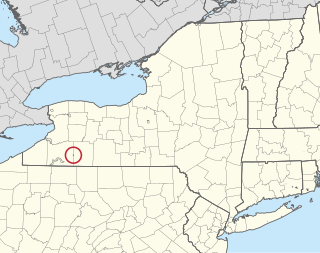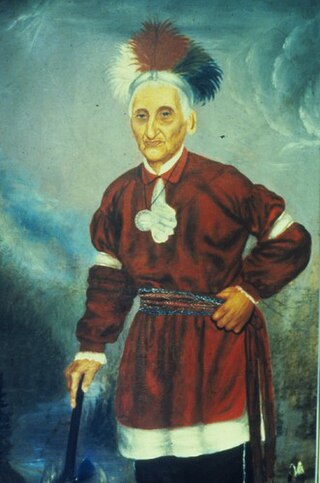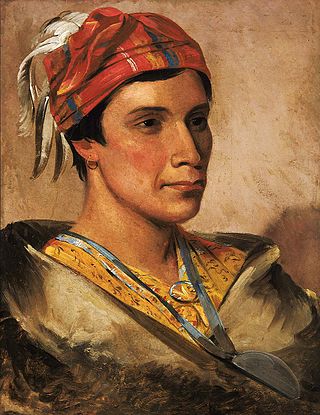Related Research Articles

Among the Haudenosaunee the Great Law of Peace, also known as Gayanashagowa, is the oral constitution of the Iroquois Confederacy. The law was written on wampum belts, conceived by Dekanawidah, known as the Great Peacemaker, and his spokesman Hiawatha. The original five member nations ratified this constitution near modern-day Victor, New York, with the sixth nation being added in 1722.

Oil Springs Reservation or Oil Spring Reservation is an Indian reservation of the federally recognized Seneca Nation that is located in southwestern New York, United States. As of the 2010 census, the Indian reservation had one resident; in 2005 no tribal members had lived on the property. The reservation covers about one square mile (2.6 km2), divided between the present-day counties of Allegany and Cattaraugus. The reservation is northwest of the village of Cuba. It is bordered by the Town of Cuba and the Town of Ischua.

The Onondaga people are one of the five original nations of the Haudenosaunee (Iroquois) Confederacy in the Northeastern Woodlands. Their historical homelands are in and around present-day Onondaga County, New York, south of Lake Ontario.

Samuel Kirkland was a Presbyterian minister and missionary among the Oneida and Tuscarora peoples of present-day central New York State. He was a long-time friend of the Oneida chief Skenandoa.
There are four treaties of Buffalo Creek, named for the Buffalo River in New York. The Second Treaty of Buffalo Creek, also known as the Treaty with the New York Indians, 1838, was signed on January 15, 1838 between the Seneca Nation, Mohawk nation, Cayuga nation, Oneida Indian Nation, Onondaga (tribe), Tuscarora (tribe) and the United States. It covered land sales of tribal reservations under the U.S. Indian Removal program, by which they planned to move most eastern tribes to Kansas Territory west of the Mississippi River.

Tah-won-ne-ahs or Thaonawyuthe, known in English as either Chainbreaker to his own people or Governor Blacksnake to the European settlers, was a Seneca war chief and sachem. Along with other Iroquois war chiefs, he led warriors to fight on the side of the British during the American Revolutionary War from 1777 to 1783. He was prominent for his role at the Battle of Oriskany, in which the Loyalist and allied forces ambushed a force of Patriots. After the war, he supported his maternal uncle, Handsome Lake, as a prominent religious leader. Chainbreaker allied with the United States in the War of 1812 and later encouraged some accommodation to European-American settlers, allowing missionaries and teachers on the Seneca reservation.

The Buffalo Creek Reservation was a tract of land surrounding Buffalo Creek in the central portion of Erie County, New York. It contained approximately 49,920 acres (202.0 km2) of land and was set aside for the Seneca Nation following negotiations with the United States after the American Revolutionary War.

The Treaty of Fort Stanwix was a treaty finalized on October 22, 1784, between the United States and Native Americans from the six nations of the Iroquois League. It was signed at Fort Stanwix, in present-day Rome, New York, and was the first of several treaties between Native Americans and the United States after the American victory in the Revolutionary War.

Tadodaho was a Native American Hoyenah (sachem) of the Onondaga nation before the Deganawidah and Hiawatha formed the Iroquois League. According to oral tradition, he had extraordinary characteristics and was widely feared, but he was persuaded to support the confederacy of the Five Nations.
The Treaty of Washington (1831) was a treaty between the Menominee and the United States Government. The treaty was initially made and signed on February 8, 1831 in Washington, D.C. In the treaty, the Menominee ceded about 2,500,000 acres of their land in Wisconsin primarily adjacent to Lake Michigan. During the ratification of the treaty in June 1832, the United States Senate modified the treaty to provide additional land for the Stockbridge-Munsee tribe. The Menominee Tribe did not agree to the changes, and the treaty was renegotiated on October 27, 1832 to resolve the differences. These two treaties are commonly referred to singularly as the Treaty of Washington.

Aboriginal title in New York refers to treaties, purchases, laws and litigation associated with land titles of aboriginal peoples of New York, in particular, to dispossession of those lands by actions of European Americans. The European purchase of lands from indigenous populations dates back to the legendary Dutch purchase of Manhattan in 1626, "the most famous land transaction of all." More than any other state, New York disregarded the Confederation Congress Proclamation of 1783 and the follow-on Nonintercourse Acts, purchasing the majority of the state directly from the Iroquois nations without federal involvement or ratification.

Eleazer Williams was a Canadian-American clergyman and missionary of Mohawk descent. In later years he claimed that he was the French "Lost Dauphin" and was a pretender to the throne of France.

Laura Cornelius Kellogg ("Minnie") ("Wynnogene"), was an Oneida leader, author, orator, activist and visionary. Kellogg, a descendant of distinguished Oneida leaders, was a founder of the Society of American Indians. Kellogg was an advocate for the renaissance and sovereignty of the Six Nations of the Iroquois, and fought for communal tribal lands, tribal autonomy and self-government. Popularly known as "Indian Princess Wynnogene," Kellogg was the voice of the Oneidas and Haudenosaunee people in national and international forums. During the 1920s and 1930s, Kellogg and her husband, Orrin J. Kellogg, pursued land claims in New York on behalf of the Six Nations people. Kellogg's "Lolomi Plan" was a Progressive Era alternative to Bureau of Indian Affairs control emphasizing indigenous American self-sufficiency, cooperative labor and organization, and capitalization of labor. According to historian Laurence Hauptman, "Kellogg helped transform the modern Iroquois, not back into their ancient League, but into major actors, activists and litigants in the modern world of the 20th century Indian politics."
Alice Mae Lee Jemison (1901–1964) was a Seneca political activist and journalist. She was a major critic of the Bureau of Indian Affairs (BIA) and the New Deal policies of its commissioner John Collier. She lobbied in support of California, Cherokee, and Sioux Indians during her career, supported by the Seneca Tribal Council. Her work was condemned by the Franklin D. Roosevelt administration and she was described harshly in press conferences and before Congressional committees, and for a time she was put under FBI surveillance.

Daniel Bread was an Oneida political and cultural leader who helped the Oneida preserve their culture while adapting to new realities during their transplantation from New York to Wisconsin. He was frequently described as a "principal chief", "head chief", or "sachem" by the Oneida but held no hereditary position and was not an officially condoled chief. Bread was a pragmatist who found ways to compromise between "promoting tribal sovereignty and treaty rights" and cooperating with federal and state officials. He played a major role in adapting the Iroquois condolence ceremony into a July 4 celebration that recognized the alliance of the Oneida with George Washington during the American Revolution. At age 14, Bread was part of the defense of Sackets Harbor during the Battle of Big Sandy Creek.
Ga-on-do-wau-na, known as Captain Pollard among other variants, was a leader of the Seneca people.
The Everett Report of 1922 was a New York State Assembly report compiled by a legislative commission led by Edward A. Everett. It concluded that "the Iroquois were fraudulently dispossessed of over six million acres of land in New York." However, the report was "buried" by New York State and not published until 1971.

Lulu G. Stillman was an American advocate for Native Americans. She worked as a stenographer and researcher to produce the Everett report, which concluded that the Iroquois had a legal right to 6,000,000 acres (2,400,000 ha) of land in New York, in the 1920s and preserved the report after it was rejected by the New York State Assembly. She subsequently became a prominent advocate on behalf of the Iroquois Nation, helping to defeat the Indian Reorganization Act in New York.

Dinah Anthony John, sometimes known as Aunt Dinah and Ta-wah-ta=whe·jah·quah among the Onondaga, was a member of the Onondaga tribe in the state of New York, United States. She was known for her longevity and close relationships to both her tribe and European-Americans, and other Americans living in the region. Upon her death in 1883, John was described as having lived to be 107, making her the oldest known Native American at the time.

Maris Bryant Pierce, was a Seneca Nation chief, lawyer, and teacher. He was a tribal land-rights activist, and a major influence to the Second Treaty of Buffalo Creek of 1838.
References
- 1 2 3 4 5 "SUNY Trustees Appoint Laurence M. Hauptman Distinguished Professor – SUNY New Paltz News" . Retrieved 2021-06-03.
- ↑ "This month scholars will participate in the 75th Annual Iroquois Research Conference. In celebration of this conference, Syracuse University Press is featuring an interview with Laurence M. Hauptman". Syracuse University Press blog. 2020-10-14. Retrieved 2021-06-03.
- 1 2 Hauptman, Laurence M. (2003). ""Going Off the Reservation": A Memoir". The Public Historian. 25 (4): 81–94. doi:10.1525/tph.2003.25.4.81. ISSN 0272-3433. JSTOR 10.1525/tph.2003.25.4.81.